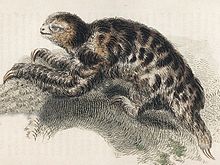Robert P. Anderson
Robert Paul Anderson is an American zoologist and mammalogist who specializes in biogeography , ecology and taxonomy . He is a professor at the City College of New York and the City University of New York and a research fellow at the American Museum of Natural History.
life and work
Anderson studied biology at Kansas State University , where 2001 with a thesis on systematics and biogeography of the South American sting heteromyidae doctorate . He then worked as a postdoctoral fellow at the American Museum of Natural History , where he developed and used methods for modeling species niches and distributions, which today are mainly used in conservation biology , the effects of invasive species and zoonotic diseases, and the effects of climate change on biodiversity can be used. Today he is a professor with a teaching position in the Department of Biology at the City College of New York as well as a research fellow in the Division of Vertebrate Zoology (Mammalogy) at the American Museum of Natural History.
In taxonomic terms, Anderson works primarily in the area of Neotropical mammals , basing his findings on field work, morphological studies, climatology, physiology and genetics. Alone or together with his colleagues and students, he described several new species of mammals such as the pygmy sloth ( Bradypus pygmaeus ) in 2001 together with Charles O. Handley, as well as four new species of the barbed mouse ( Heteromys ): the Ecuador barbed mouse ( Heteromys teleus ) in 2002, the Paraguaná barbed pocket mouse ( Heteromys oasicus ) 2003, the cloud forest barbed pocket mouse ( Heteromys nubicolens ) 2006 and the Aragua barbed pocket mouse ( Heteromys catopterius ) 2009.
Publications
In addition to numerous publications in various scientific journals, Anderson is co-editor of a collection of monographs and author of the 2015 chapter on the quill mice in the Mammals of South America framework :
- AT Peterson, J. Soberón, RG Pearson, RP Anderson, E. Martínez-Meyer, M. Nakamura, MB Araújo: Ecological niches and geographic distributions. Monographs in Population Biology 49, Princeton University Press 2011.
- RP Anderson: Family Heteromyidae. In: JL Patton, UFJ Pardiñas, G. D'Elía (Eds.): Mammals of South America, Volume 2: Rodents. University of Chicago Press, 2015; Pp. 51-58.
supporting documents
- ^ RP Anderson: Systematics and biogeographic modeling of spiny pocket mice (Rodentia: Heteromyidae: Heteromys) in South America. Ph.D. Dissertation, University of Kansas, Lawrence, 2001.
- ↑ Robert P. Anderson, Charles O. Handley, Jr: A new species of three-toed sloth (Mammalia: Xenarthra) from Panamá, with a review of the genus Bradypus. Proceedings of the Biological Society of Washington 114, 2001, pp. 1-33
- ↑ Robert P. Anderson, Charles O. Handley, Jr: Dwarfism in insular sloths: biogeography, selection, and evolutionary rate. Evolution 56, 2002, pp. 1045-1058
- ^ Robert P. Andersen, Pablo Jarrín-Valladares: A New Species of Spiny Pocket Mouse (Heteromyidae: Heteromys) Endemic to Western Ecuador. American Museum Novitates 3382, Aug. 16, 2002; Pp. 1-26. ( Full text )
- ^ Robert P. Andersen: Taxonomy, distribution, and natural history of the genus Heteromys (Rodentia, Heteromyidae) in western Venezuela, with the description of a dwarf species from the Península de Paraguaná. American Museum Novitates 3396, March 27, 2003; Pp. 1-43. ( Full text )
- ^ Robert P. Andersen, Eliécer E. Gutiérrez: Taxonomy, Distribution, and Natural History of the Genus Heteromys (Rodentia: Heteromyidae) in Central and Eastern Venezuela, with the Description of a New Species from the Cordillera de la Costa. Bulletin of the American Museum of Natural History 331 (1), 2009; Pp. 33-93. ( Full text , doi : 10.1206 / 582-2.1 )
- ^ List of publications by Robert P. Andersen on the official website of the Anderson Lab at the City College of New York; accessed on January 2, 2019.
Web links
- Official website of the Anderson Lab at the City College of New York
- Robert P. Anderson , profile at researchgate.net
| personal data | |
|---|---|
| SURNAME | Anderson, Robert P. |
| ALTERNATIVE NAMES | Anderson, Robert Paul (full name) |
| BRIEF DESCRIPTION | American zoologist and mammal logist |
| DATE OF BIRTH | 20th century |
